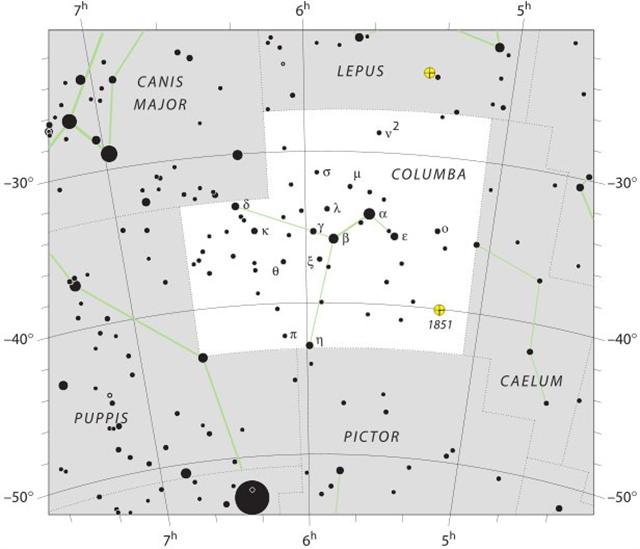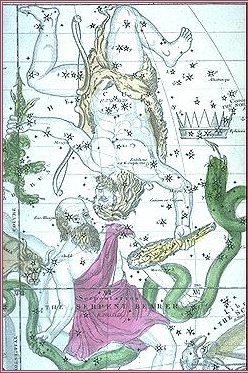Now it is time to update my list with the remaining Greek lettered stars in Columba: 
The first star of Columba, the little 'egg' (o mikron), arrived in the day after Rigel and possibly it was illustrated as a fluid kava. The position in the nakshatra system was 8 * 29½ + 1 = 237. And it was the 1st of the 4 days at the end of Rohini. I have redmarked ρ Herculis, which I imagine was a star that close to the Full Moon (in the June 8 night) confirmed how Sun now had crossed the boundary between day 236 (= 8 * 29½) and day 237 in the nakshatra system.
The Hercules constellation depicts the spring giant upside down. It means his rule is over. The position of ρ is where his bow is crossing his left thigh:
... Resh (Arabic: rāۥ) is the twentieth letter of many Semitic alphabets, including Phoenician, Aramaic, Hebrew ... The word resh is usually assumed to have come from a pictogram of a head, ultimately reflecting Proto-Semitic *raۥ(i)š-. The word's East Semitic cognate, rēš-, was one possible phonetic reading of the Sumerian cuneiform sign for 'head (SAG) ... ... Hercules first appears in legend as a pastoral sacred king and, perhaps because shepherds welcome the birth of twin lambs, is a twin himself. His characteristics and history can be deduced from a mass of legends, folk-customs and megalithic monuments. He is the rain-maker of his tribe and a sort of human thunder-storm. Legends connect him with Libya and the Atlas Mountains; he may well have originated thereabouts in Palaeolithic times. The priests of Egyptian Thebes, who called him Shu, dated his origin as '17,000 years before the reign of King Amasis'. He carries an oak-club, because the oak provides his beasts and his people with mast and because it attracts lightning more than any other tree. His symbols are the acorn; the rock-dove, which nests in oaks as well as in clefts of rocks; the mistletoe, or Loranthus; and the serpent. All these are sexual emblems. The dove was sacred to the Love-goddess of Greece and Syria; the serpent was the most ancient of phallic totem-beasts; the cupped acorn stood for the glans penis in both Greek and Latin; the mistletoe was an all-heal and its names viscus (Latin) and ixias (Greek) are connected with vis and ischus (strength) - probably because of the spermal viscosity of its berries, sperm being the vehicle of life ... Also the G text, we remember, has an upside down figure in position 237:
But the position in G is - according to my reconstruction - Gregorian day 380 instead of December 9 (343). Counting 380 - 343 = 37 (= 237 - 200), suggests the G text could begin 37 days earlier than the C text. April 17 (107) = 70 (March 11) + 37. Rogo in Gb6-26 (409) is probably at March 21. 10 days earlier is March 11 (399). The synodic cycle of Jupiter (Father Light) is 399 days. |













